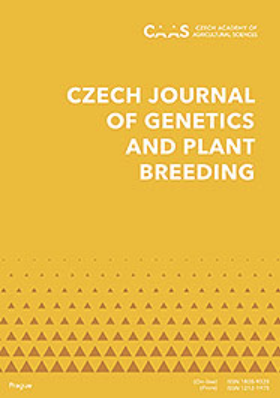Effect of terminal heat stress on physiological traits, grain zinc and iron content in wheat (Triticum aestivum L.)
IF 1.8
4区 农林科学
Q3 AGRONOMY
引用次数: 14
Abstract
Heat stress is one of the major wheat (Triticum aestivum) production constraints in South Asia (SA), particularly in the Eastern Gangetic Plains (EGP) of India and Bangladesh. Malnutrition is also a severe problem among children and women in SA. Wheat varieties with high grain Zn/Fe are a sustainable, cost-effective solution in the fight against hidden hunger. Thirty wheat genotypes were characterised under the optimum temperature and heat stress conditions in 2016–2017 and 2017–2018 to study the response of the stress on the yield, physiological traits and grain Zn/Fe content. A significant genetic variation was observed for all the traits under the optimum temperature and stress conditions. The yield was reduced by an average of 59.5% under heat stress compared to that of the optimum temperature. A strong positive association of the canopy temperature depression (CTD) with the grain yield (GY) was observed under the heat stress. A negative correlation of the grain Zn/Fe with the yield was observed under the optimum temperature and heat stress conditions, while the association between the grain Zn and Fe was positive. The genotypes BRW 3723, BRW 3759, BRW 3797, BRW 160, HD 2967, HD 2640 were found to be heat-tolerant in both years. Among the tolerant genotypes, BRW 934, BRW 3807 and BRW 3804 showed a high zinc content and BRW 934, BRW 3797, BRW 3788 and BRW 3807 showed a high iron content, respectively. These genotypes can be explored in future breeding programmes to address the problem of nutritional deficiency.末热胁迫对小麦生理性状及籽粒锌、铁含量的影响
热应激是南亚(SA)小麦(Triticum aestivum)生产的主要制约因素之一,特别是在印度和孟加拉国的东恒河平原(EGP)。营养不良也是南非儿童和妇女的一个严重问题。谷物锌铁比高的小麦品种是对抗隐性饥饿的一种可持续的、具有成本效益的解决方案。在2016-2017年和2017-2018年最适温度和热胁迫条件下,对30个小麦基因型进行了表征,研究了胁迫对产量、生理性状和籽粒锌铁含量的响应。在最适温度和最适胁迫条件下,各性状均有显著的遗传变异。与最佳温度相比,热胁迫下的产量平均降低了59.5%。热胁迫下,冠层温度下降与籽粒产量呈显著正相关。在最适温度和热胁迫条件下,籽粒Zn/Fe与产量呈负相关,而籽粒Zn/Fe与产量呈正相关。基因型BRW 3723、BRW 3759、BRW 3797、BRW 160、HD 2967、HD 2640在这两个年份均具有耐热性。耐盐基因型中,BRW 934、BRW 3807和BRW 3804锌含量较高,BRW 934、BRW 3797、BRW 3788和BRW 3807铁含量较高。这些基因型可以在未来的育种计划中加以探索,以解决营养缺乏的问题。
本文章由计算机程序翻译,如有差异,请以英文原文为准。
求助全文
约1分钟内获得全文
求助全文
来源期刊

Czech Journal of Genetics and Plant Breeding
Agricultural and Biological Sciences-Plant Science
CiteScore
2.20
自引率
0.00%
发文量
25
审稿时长
>12 weeks
期刊介绍:
Original scientific papers, critical reviews articles and short communications from the field of theoretical and applied plant genetics, plant biotechnology and plant breeding. Papers are published in English.
 求助内容:
求助内容: 应助结果提醒方式:
应助结果提醒方式:


